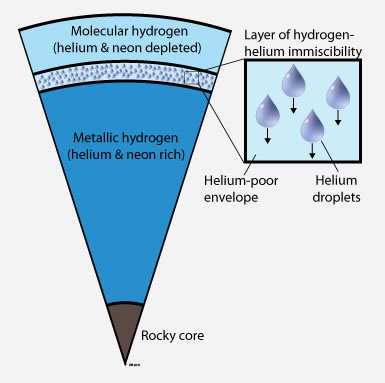Jupiter Has Helium Rain, Study Suggests

Drops of liquid helium raining down on Jupiter may explain the planet's odd lack of neon high up in its atmosphere, a new study suggests.
Neon, a scarce gas in the upper realm of Jupiter's atmosphere, may be leeched out its original location by combining with condensed helium and then raining down to lower atmospheric levels on the gas giant, according to the science team behind the study.
"Helium condenses initially as a mist in the upper layer, like a cloud, and as the droplets get larger, they fall toward the deeper interior," Hugh Wilson said, a post-doctoral fellow at UC Berkeley and co-author of the new study.
Neon, which mixes easily with helium, dissolves in the helium raindrops, and together they fall to the interior of Jupiter. Wilson and colleague Burkhard Militzer, an assistant astronomy professor at Berkeley, used computer simulations to predict the link between Jupiter's missing neon and helium rain.
Still, Militzer notes that the concept of rain as we understand it on Earth is an imperfect analogy for the process of helium rain on Jupiter.
For one, the helium droplets form at a distance of about 6,000 to 8,000 miles (10,000 to 13,000 km) below the tops of Jupiter's hydrogen clouds under extreme conditions. At this distance, the pressure is one to two million times the atmospheric pressure on Earth, and temperatures reach approximately 9,000 degrees Fahrenheit (about 5,000 degrees Celsius). [Jupiter Gallery]
Under such conditions, hydrogen turns into a conductive metal, but helium does not. The helium instead separates from the metallic hydrogen and forms droplets — like drops of oil in water. The resulting rain essentially consists of liquid helium droplets mixed with neon falling through a liquid atmosphere of metallic hydrogen.
Breaking space news, the latest updates on rocket launches, skywatching events and more!
As those droplets fall, the planet's upper layers are depleted of both helium and neon, which is consistent with measured concentrations that record low levels of both elements within Jupiter's hydrogen-rich atmosphere.
The inspiration for Militzer and Wilson's research came from discoveries of neon depletion made by the Galileo probe that descended through Jupiter's atmosphere in 1995. That probe recorded measurements of temperature, pressure and elemental abundance before it was crushed under the weight of the immense atmospheric pressure of the gas giant planet.
Helium rain has also been proposed to explain Saturn's excessive brightness and temperature.
Saturn, a gas giant like Jupiter (but just one-third the mass), is slightly warmer than it should be based on the ringed planet's age and predicted rate of cooling. In this case, scientists think that falling helium rain releases heat, which would account for the warmer temperatures.
Militzer and Wilson's predictions, which will be detailed in the March 26 issue of Physical Review Letters, will help refine models of Jupiter's interior, in addition to furthering the field of research concerned with modeling planetary interiors.
The study will also provide relevant information for NASA's Juno mission to Jupiter, which is scheduled to launch next year.
- Images — Visions of Jupiter
- Secrets of Jupiter's Great Red Spot Revealed in New Weather Map
- Top 10 Extreme Planet Facts

Denise Chow is a former Space.com staff writer who then worked as assistant managing editor at Live Science before moving to NBC News as a science reporter, where she focuses on general science and climate change. She spent two years with Space.com, writing about rocket launches and covering NASA's final three space shuttle missions, before joining the Live Science team in 2013. A Canadian transplant, Denise has a bachelor's degree from the University of Toronto, and a master's degree in journalism from New York University. At NBC News, Denise covers general science and climate change.
